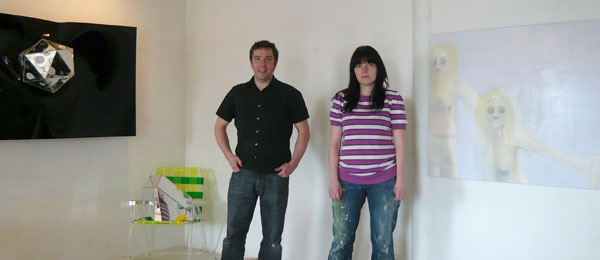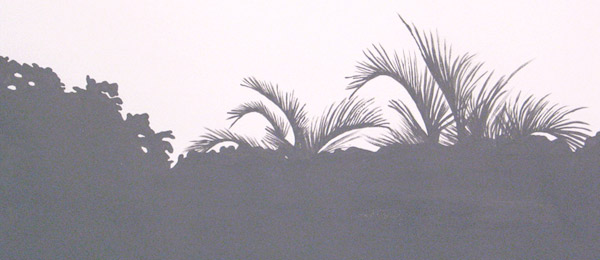
Scattered boxes overflow with extension cords, spray foam and q-tips, adjacent to the plastic covered art on the whitish floors of our new studio space. I look to the window and notice a refurbished school bus, with bullet proof glass and Department of Corrections painted on the side slowly passing by in the stalled traffic of BQE. We discuss what kind of work-duty the prisoners’ day excursion will consist of. Mike thinks it will be roadside beautification; I, on the other hand, hoped it was their one-way ride to Riker’s Island. Mike pointed out that Riker’s was closer to the Bronx and we were in Brooklyn, oh right.
Saira-Some of your recent work are representations of everyday items. Things you would see in the garbage or on the street, or perhaps roadside on the highway, ready for prisoner’s to clean up as their debt to society.This gives your work has an implied delicate fragility, when I see a plastic bag I immediately think of it floating in a breeze, and yet because yours is made out of acrylic it has this industrial resilience.
Mike- That sounds really good. But I think at the time I was exploring what I could do with the plastic. I had a plastic bag from Chinatown that said “see you soon” I thought that was kind of funny. So I thought I would make a model of it.... not that I could make one plastic object more permanent than another but I could give it rigidity. Somehow I thought that would make it more of an object. Maybe simply trying to raise awareness of appreciation that I saw in the original.
Mike-Your work is moving away from clear definable subject matter, towards abstraction. Your work is beginning to oscillate between figurative and color field.
Saira- Well I am interested in the way our brain remembers. My work is always in someway dealing with either the failure or the persistence of memory. The work I am doing now is dealing with collective memory specific to political uprising... well, really marches and protests. I wanted to approach it in different way than other artists who work with memory. I wanted to diverge from the model of the faded photograph. I do use photographs as the starting point, I began to recognize that the individual subject was not as important to me as what they were able to evoke- and this became easier to achieve the more I began to move into abstraction.
Saira- Tell me about your meteor piece. I interpreted it as; this meter crashes into some far away moon or planet and all of your other pieces are relics from this place, at once anthropological and mythological.
Mike- As I made this piece one of the things I thought about that stuck with me was that on the front of the piece is a representation of an object pushing through empty space and on the back is the depiction of a crater. This crater shape is a direct result of the object on the front being pushed into the acrylic. So in a way I’m showing this meteor flying through space and the result of it impacting somewhere with one action, one object and on the same plane.
Mike-Some of your imagery has an element of creepiness to it. Do you attribute that purely to the technique or style of your painting and its relationship to depicting memory or is their something else there? Something dark?
Saira- I am never conscious of creating dark or creepy imagery. I think some level all memory has an inherent darkness, a haunting. Memory is also representative of loss, loss of time, loss of attachments, loss of youth. The way our brain remembers is to actually lose details each time a memory is recalled. This loss is a frightening reality to me.
We look to window again, the corrections bus has made it past our view and a rust colored GMC van has taken its place in line.





